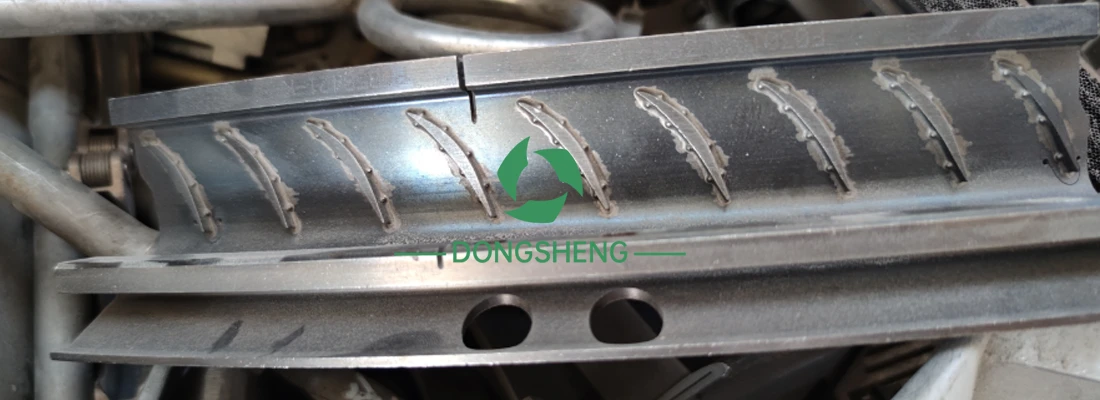In actual turbine blade recycling, palladium is mainly concentrated in the welded seams and coating areas of the blades. DONGSHENG Precious Metals Recycler uses a melting and refining process to extract palladium and other rare metals from retired turbine blades. However, the recovery rate for palladium is significantly lower than that for rhenium (approximately 2% content), as palladium exists in the alloy as a trace additive and is prone to oxidation and loss during high-temperature melting. European recycling plants use hydrometallurgical technology to selectively dissolve palladium by immersing crushed blade debris in an acidic solvent, followed by electrolytic deposition for purification. This process requires strict control of pH to prevent fiber impurities from entering, with palladium purity reaching up to 99.5% per batch.

The core challenge in turbine blade recycling lies in the efficient separation of composite material interfaces. Turbine blades are composed of nickel-based high-temperature alloys (such as K465) and ceramic coatings, which are tightly bonded by chemical bonds. Traditional mechanical crushing methods cause fiber breakage and metal powder contamination, reducing the quality of recycled products. Japan's K┼Źsei Plant employs electroslag remelting (ESR) technology: during the pre-treatment stage, blades are sandblasted and acid-washed to remove surface oxides; during the remelting stage, refining is conducted in a vacuum environment below 0.67 Pa to separate the alloy matrix from coating impurities. However, rhenium is prone to volatilization and loss during high-temperature remelting, necessitating argon gas injection for protection, which increases energy consumption by 30%.
Another challenge is the treatment of resin-based coatings. The chemical depolymerization process developed by Vestas can be referenced: using dimethylformamide solvent to crack epoxy resin at 240┬░C, releasing the fiber skeleton. However, aviation resins have higher thermal stability, requiring ultrasonic assistance for degradation, which increases equipment complexity.
The economic viability of turbine blade recycling depends on metal content and process costs:
High-value grade: Turbine blades containing Ōēź4% rhenium (e.g., high-pressure stage blades from commercial aircraft engines) can yield 20 kg of rhenium per ton of scrap. Based on current rhenium prices of $3,000ŌĆō$6,000 per kilogram, the recycling value is approximately $60,000ŌĆō$120,000 per ton. HONGKONG DONGSHENG Precious Metal Recycling Company processes 50 tons of scrap blades annually.
Medium-to-low value grade: Military engine or auxiliary turbine blades with rhenium content Ōēż2%, and containing low-value metals such as tungsten and molybdenum. Melting and purification costs account for 45% of total costs, reducing net profits to USD 10,000ŌĆō15,000 per ton.
Recyclers must bear hidden costs: cross-border transportation of waste blades must comply with the Basel Convention's provisions on the transfer of hazardous waste, increasing compliance costs by 15%; the recycling rate of chemical solvents (such as zinc acetate) must exceed 90% to maintain economic viability.
In addition to turbine blade recycling, the following components are prioritized for recovery when aircraft are retired:
Ignition system components: Spark plug electrodes contain iridium alloys, with each piece yielding 0.5ŌĆō1 grams of iridium. High-temperature smelting separates the ceramic casing, achieving an iridium recovery rate exceeding 95%.
Electronic contacts and sensors: Airplane gold plated circuit board have gold plating up to 50╬╝m thick, much thicker than common electronics. Using cyanide leaching, 10-20 grams of gold can be recovered per kilogram of scrap, however this requires gas treatment systems.
Exhaust catalysts: Platinum/rhodium catalyst coatings are attached to the engine exhaust nozzles, and the recovery process is similar to that of automotive catalytic converters. The acid leaching-precipitation method can extract 90% of platinum group metals, but aviation catalysts have a more complex structure, requiring extended reaction times of up to 72 hours.
Turbine blade recycling remains the core value of aircraft end-of-life processing, but benefits can be enhanced through precise sorting, low-carbon processes, and supply chain collaboration. Over the next five years, the EU will enforce an 85% aircraft recycling rate standard, making turbine blade recycling technology a key competitive factor in the market.